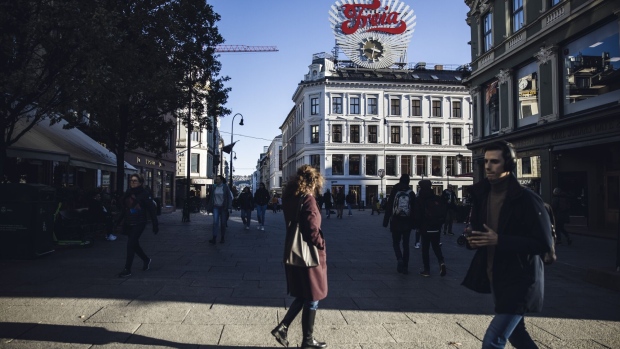May 10, 2024
Norway’s Core Inflation Slowed Less Than Expected in April
, Bloomberg News

(Bloomberg) -- Norway’s underlying inflation rate fell less than analysts expected last month, likely reducing expectations that the central bank will deliver its first interest-rate cut this year.
The core inflation rate, which excludes volatile items such as energy, eased to 4.4% in April, according to a statement from the statistics office on Friday. That’s just below the Norges Bank’s projection of 4.5%, while the median forecast in a Bloomberg survey of analysts was for a 4.2% pace.
The data suggest price pressure in the fossil-fuel rich Nordic nation remains more stubborn than in its European peers, at a time a renewed weakness in the krone threatens to fuel imported inflation. It also means there are even fewer factors to sway Norwegian policymakers from their higher-for-longer stance.
“Norges Bank needs to be convinced that core inflation will reach 2% and we believe that is still a long way out with a weak krone, high nominal wage growth and with still high rent increases for some time,” Nordea Bank Abp’s senior strategist, Dane Cekov, said in a note to clients. “We still believe that Norges Bank won’t cut the key rate until next year and see only two cuts to 4% until the end of 2025.”
The Norwegian currency, among the weakest performers in the G-10 space of major currencies this year, strengthened as much as 0.2% after the news, trading at 11.6716 per euro as of 9:19 a.m. in Oslo.
Last week, Governor Ida Wolden Bache and other rate-setters said the recent krone development, along with data on wage growth and a more resilient economy, suggest that the first interest-rate cut may need to be delayed beyond autumn.
Read More: Norway Opens Door to Rate-Cut Delay Amid Krone Weakness
Norway’s average price growth is still expected to remain the fastest among the G-10 members this year, according to data compiled by Bloomberg.
Headline inflation slowed to a seven-month low of 3.6% in April, also slightly exceeding the median forecast by analysts. The decline was mainly supported by lower electricity prices, which aren’t included in core inflation data, the statistics office said.
“The rise in prices for Norwegian-produced goods and services is still difficult to bring down,” Marius Gonsholt Hov, the Oslo-based chief economist with Svenska Handelsbanken AB, said in an emailed comment. “We expect Norges Bank to keep the interest rates unchanged until at least December.”
In neighboring Denmark, inflation slowed to 0.8% in April, helped mainly by lower costs of furniture and household equipment, according to a statement from Statistics Denmark.
--With assistance from Joel Rinneby.
(Updates with details, analyst comments from fourth paragraph.)
©2024 Bloomberg L.P.






